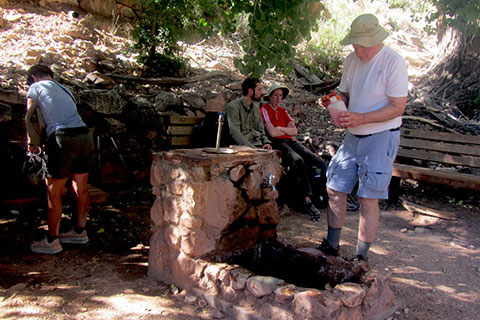| 740 | Self Rescue Take a Break |
2012-12-07 |

When hiking friends of mine read that I am writing about taking breaks on the trail, in utter disbelief they will sit posed at their computers ready to dash a quick scathing comment calling me a hypocrite - no doubt.
So, yes it is true, I am not a big fan of break taking when I hike. I do however try to walk at a speed that I can maintain for the duration of the hike. But, even while walking at a slow speed, I still have to take breaks - even if they are usually very short.
Breaks, speed, and rest are all dictated by the hiker's fitness level, training, the conditions, gear (how well the gear is performing and the amount or weight), and just how they feel.
Years ago, when we - my wife, daughter, and I hiked the La Luz Trail (for the first time), poor planning had us traversing the desert lowlands for a few miles in the heat of the day. It was extremely hot. We had trained for the trip and were fit. We didn't carry much weight in our light packs, but the heat was intense. We found ourselves searching for any shade where we could take small breaks to avoid overheating.
Then, last summer on the Bright Angel Trail, we found ourselves and the masses of other hikers crowded into (or around) the rest areas (or rest houses) on the trail. Once again the rests were to avoid overheating.
So for a few Take a Break tips ...
The Self-Rescue Tips we are using for this series were outlined by the Hike Smart and Grand Canyon National Park Search and Rescue Service programs. Heat is a definitely a problem for hikers in the Canyon. Taking a break at the rest areas is important to avoid overheating.
Listen to your body.
I actually like to take breaks, long breaks, the only problem is I hate to restart after long breaks - that is why I like to keep breaks as short as possible.
With experience, miles on the trail, you will be better at reading your needs and what will be required. On a trip to the Tetons, a friend - on his first trip to the range, exclaimed over and over again, that was the hardest thing I have EVER done in my life. He was pushing his limits.
Always take a break at every trail junction. Consult the map before continuing.
At every small break, drink water, eat a bit of food, and adjust your clothing.
Taking pictures is a good reason for a break. Filtering water is also a good chore related break.
In cooler weathers, the first thing I do at a rest is to put on a jacket.
In the heat, it is a good idea to pack a shade umbrella and take it out at breaks.
When hiking with a group, the breaks need to fill the needs of the multitude. The leader should monitor everyone in the group.
Use breaks to revitalize your body.
No two breaks will ever be the same. Your body is ever changing and so are the conditions.
Find what works best for you.
Be safe out there. Take breaks as needed.
Happy Take a Break on the trails
Down is Optional ... Up is Mandatory - introduction
Self Rescue on Trails - the program
Self Rescue - Plan Ahead - plan to prevent
Self Rescue - Be Kind to Yourself - don't make it hard, make it easy
Self Rescue - Be a Lightweight - walk light and easy
Self Rescue - Avoid Huffing and Puffing - listen to your body and control your speed
Self Rescue - Take a Break - give your body a chance to recover
Self Rescue - No Food, No Fuel, No Fun - feed the motor
Self Rescue - Watch Your Time - always know your location, time, and speed